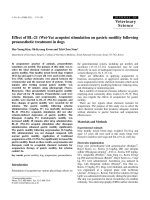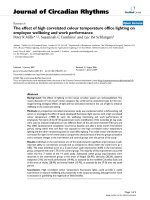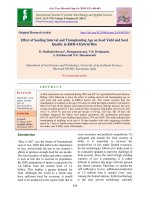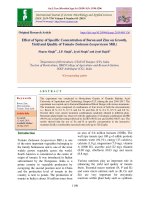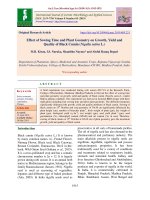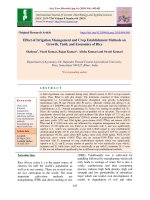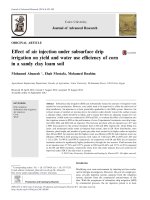Effect of herbal feed supplementation shatavari (Asparagus racemosus) on milk yield and post-partum estrus in lactating sahiwal crossbred cows
Bạn đang xem bản rút gọn của tài liệu. Xem và tải ngay bản đầy đủ của tài liệu tại đây (269.28 KB, 8 trang )
Int.J.Curr.Microbiol.App.Sci (2020) 9(2): 2921-2928
International Journal of Current Microbiology and Applied Sciences
ISSN: 2319-7706 Volume 9 Number 2 (2020)
Journal homepage:
Original Research Article
/>
Effect of Herbal Feed Supplementation Shatavari (Asparagus racemosus) on
Milk Yield and Post-Partum Estrus in Lactating Sahiwal Crossbred Cows
Hitesh Muwal1*, D. C. Rai1, Vinod Bhateshwar1, Dwarki Lal1 and Hanuman Lal Nehra2
1
Department of Animal Husbandry & Dairying, Banaras Hindu University,
Varanasi (U.P.) India
2
Department of Livestock Production Management, Sri Karan Narendra
Agriculture University, Jobner, Rajasthan India
*Corresponding author
ABSTRACT
Keywords
Shatavari, Sahwail,
Crossbred, Milk
yield and PostPartum estrus
Article Info
Accepted:
20 January 2020
Available Online:
10 February 2020
The present investigation was conducted to assess the effect of herbal feed
supplementation Shatavari (Asparagus racemosus) on milk yield and PostPartum estrus in lactating Sahiwal crossbred cows during summer season
on twenty lactating Sahiwal crossbred (Holstein Friesian x Sahiwal) cows
in early stage of lactation were selected for the experiment between 1
February 2019 to 31 May 2019 (120 days Post-Partum). All the cows were
randomly divided into two groups T1 (control) and T2 (Treatment) of 10 in
each group. The treatment group was provided Shatavari root powder @ 50
g/head/day for 90 days Post-Partum. Data related to Milk production take
fortnightly interval. The average fortnightly milk yield of 90 days lactation
trail was 9.88±0.15 and 10.87±0.41 kg/d in T1 (control) and T2 groups
respectively and was significantly (P<0.05) higher in T2 than the T1
(control). Mean of first Post-Partum estrus and service period was
77.50±2.50 and 52.83±1.27 days, and 112.50±2.50 and 90.16±1.44 days
respectively, in the T1 (control) and T2 group was significantly reduced
(P<0.05).
Introduction
India, a developing country is a land of
villages and more than 70 % of the human
population still depends upon agriculture and
livestock sector for their livelihood. Livestock
sector plays a critical role in the welfare of
India’s rural population. India is the highest
milk producer in the world and with increase
in number of milch animals (in-milk and dry)
in cows and buffaloes have increased from
111.09 million to 118.59 million, an increase
of 6.75% (19th Livestock census, 2012). The
growth is on account of both improvements in
2921
Int.J.Curr.Microbiol.App.Sci (2020) 9(2): 2921-2928
productivity and shift in priorities towards
buffalo and crossbred cattle. Yet, the
productivity is low compared to the potential
and world average. Out of the total 190.90
million cattle present in India, 39.73 million
are crossbred cattle (19th Livestock census,
2012). Contribution of crossbred cattle to the
44% of the total cattle milk production was
16% (Singh, et al., 2008) 6.75 vs. 1.98 lit/day
(Hegde, 2010). They are more prone to
environmental stress, diseases and infertility
and sub-fertility due to sub-estrous, anoestrus,
repeat breeding and longer Post-Partum
interval (PPI) days open and service per
conception.
Sahiwal cow a zebu breed of cattle has all the
desirable characteristics for an efficient dairy
animal in addition to high milk yields viz.
heat tolerance, tick and parasite resistance,
ease of calving, bloat tolerant, good
temperament and disease resistance which are
perfectly suited for arid and tropical climatic
condition. There is a need for agents to
alleviate
environmental
stressors
for
improving productivity in this breed of cattle.
Sahiwal is the heaviest milker of all zebu
breeds and display a well-developed udder.
The ancient history of India is very rich in
herbal medicine. Ayurveda, one of the oldest
surviving systems of health care in the world
is totally based on herbs. There are several
herbs which have been described in the
Ayurveda to improve the general well beings,
milk production and reproduction of both
human and animals. Among them, Shatavari
(Asparagus racemosus) needs a special
mention.
Ayurveda described that Shatavari overcomes
all reproduction related complications and
improves overall physiological system so
called pillars of health including digestion,
energy metabolism, immune and reproductive
system. Shatavari is a creeper grown in all the
tropical countries which is an important
medicinal plant of tropical and subtropical
India since prehistoric times. The genus
Asparagus includes about 300 species around
the world.
Out of these, 22 species of Asparagus are
found in India; In Sanskrit, the meaning of
Shatavari is described as “able to have one
hundred husbands” and in Ayurveda this
amazing herb is known as the “queen of
herbs”. In Ayurveda, Shatavari has been
described as absolutely safe for long term use,
even during pregnancy and lactation. So it is
recommended during last and first trimester
of pregnancy to restore the mother’s energy,
boost the immunity of both mother and
foetus, promote quality breast milk and
promote digestion (Maasaanumaasi kapathya,
Garbhini Paricharya, Prasuthi Tantra,
Ayurveda).
Materials and Methods
Place of work
The present study was conducted on lactating
Sahiwal crossbred cows reared at Gaushala
Dairy Farm, Department of Animal
Husbandry and Dairying, Institute of
Agricultural Sciences, Banaras Hindu
University, Varanasi, Uttar Pradesh between 1
February 2019 to 31 May 2019 (120 days of
Post-Partum) during summer season.
Selection of experimental animals and
treatments
Twenty lactating Sahiwal crossbred (Holstein
Friesian x Sahiwal) cows in early stage of
lactation were selected for the experiment. At
the end of acclimatisation period all the cows
were randomly divided into two groups T1
(control) and T2 (Treatment) of 10 in each
group on basis of nearest in their body weight,
number of lactation and milk yield of average
per day.
2922
Int.J.Curr.Microbiol.App.Sci (2020) 9(2): 2921-2928
Housing and management of experimental
animals
Similar housing and managemental facilities
were provided to all the groups. The
experimental crossbred cows were kept
individually tied day and night during
experimental period in cattle shed. The
animals were offered individual feeding. The
floor area was paved with cement concrete
duly corrugated to prevent the animal from
slipping. The animals were washed daily
before milking at day time when the sun light
was clear. The shed was cleaned daily early in
the morning. All crossbred cows were
dewormed with suitable anthelmentics for
removing parasitic eggs before the start of
actual experiment.
identifying cows in estrus. Teaser bull was
used after one month of parturition. Estrus
was also detected by visualizing various
estrus behaviour signs. The estrus signs like
bellowing, frequent micturition, mucus
discharge, wagging of tail and stand to be
mounted were noted in cows induced to
estrus.
Statistical Analysis
Feeding of experimental animals
Data related to milk yield and Post-Partum
estrus were statistically analyzed using the
one-way analysis of variance (SPSS version
21.0) for completely randomized design. All
statement of significant differences was based
on the 0.05 probability level. Significant
differences among treatment, within the
experiment, were analyzed using the SPSS
statistical software program.
Milk yield
Results and Discussion
During the month of February 2019 after
calving, for individual lactating cow milk
yield was measured at 15 days intervals (i.e.,
on 0, 15, 30, 45, 60, 75, and 90) using a
digital balance and milking was done by
hand milking. Before every milking, lactating
cows were cleaned and rinse properly. The
milk yield was recorded in litre. Hand milking
was performed on two occasions (morning at
5:00 am and afternoon at 4:00 pm). After
milking the milk was collected in milk can
after screening through muslin cloth.
Milk yield
Post-Partum estrus estimation
After parturition all experimental animals
were observed regularly for first symptom of
heat during both morning and evening. The
interval from parturition to first symptom of
heat was recorded to determine days from
calving to first heat. Estrus detection was
being carried out by teaser bull which was
used twice a day (morning and evening) for
The average fortnightly milk yield of 90 days
lactation trial was (Table 2) 9.88±0.15 and
10.87±0.41 kg/d in T1 (control) and T2 groups
respectively and it was found that milk yield
increased significantly (P<0.05) higher in T2
than the T1 (control). The milk yield ranged
between 9.41±0.35 to 10.54±0.26 and
9.62±0.44 to 12.39±0.19 kg/d in T1 (control)
and T2 groups respectively in different
fortnights. Statistical analysis of data found
positively significant variation between the
groups. The similar result also found by
Tanwar et al., (2008) evaluated significant
improvement in overall milk yield were
increased 1.06±0.17 kg (11.47%) daily and
average milk yield in buffaloes and cows
were increased 0.8±0.34 kg (9.0%), 1.32±0.15
kg (12.72%) respectively as compared to their
previous production. Shatavari significantly
(P<0.05) increased milk production during
supplementation by 20 percent in treatment
2923
Int.J.Curr.Microbiol.App.Sci (2020) 9(2): 2921-2928
group (23.40 kg) over control group (19.50
kg) (Santosh, 2009). Sharma (2010) also
found that polyherbal supplementation
containing Shatavari @ 200 mg/kg BW,
significantly increased the milk yield by
12.24,
15.01
and
10.50%
during
supplementation, residual and post residual
periods, respectively. The milk production
was increased 0.60±0.27 kg (9.67%) daily
respectively as compared to their previous
production supplementation of 50 gm powder
of shatavari roots in concentrates (Jingar et
al., 2018).
Table.1 Distribution of experimental lactating Sahiwal crossbred cows
Treatments
Tag No. of
Animal
Body weight
(in kg)
Lactation No.
Milk production
(in litres/day)
T1
604
462.48
02
9.20
930
428.85
03
10.12
494
350.43
05
8.20
801
452.80
07
9.00
934
392.39
01
8.00
792
345.12
03
10.00
640
472.82
08
10.25
727
360.55
01
9.50
935
465.62
06
10.35
885
378.04
04
9.60
Average
-
410.91±16.16
-
9.41±0.35
T2
768
482.40
06
9.20
637
465.21
01
10.16
564
362.05
09
8.75
878
452.70
03
9.93
806
349.44
05
10.32
789
455.38
02
9.40
766
360.11
07
10.82
609
341.28
05
8.00
786
450.12
08
10.58
894
381.58
04
9.18
-
410.02±17.56
-
9.62±0.44
Average
2924
Int.J.Curr.Microbiol.App.Sci (2020) 9(2): 2921-2928
Table.1(A) Feeding schedule of lactating Sahiwal crossbred cows
S. No.
Feed and fodders
Quantity of feed and fodders
1.
Wheat straw
8.0 kg offered and fed ad lib.
2.
Concentrate mixture
2.0 kg for maintenance ration/animal and @ 1.0 kg/2.5 litre
milk yield for production ration
3.
Green fodder (Lucerne)
5.0 kg/head/day
4.
Shatavari root powder
@ 50 g/head/day was offered
Table.2 Fortnightly milk yield (lit.) supplementation with or without
Shatavari root powder during the experiment
Days
0
15
30
45
60
75
90
Overall mean
Treatments
T1 (Control)
T2
9.41±0.35
9.62±0.44
9.53±0.56
9.78±0.58
9.65±0.48
10.15±0.24
9.80±0.26
10.73±0.15
10.00±0.20
11.54±0.10
10.28±0.11
11.92±0.23
10.54±0.26
12.39±0.19
9.88±0.15
10.87±0.41
Table.3 Effect of Shatavari root powder supplementation on reproductive
performance in lactating Sahiwal crossbred cows
Reproductive parameter
Treatments
T1 (Control)
T2
Number of animals
10
10
First Post-Partum estrus (days)
77.50±2.50
52.83±1.27
Service period (days)
112.50±2.50
90.16±1.44
Total conceived
2
6
Conception rate (%)
20
60
Nature of discharge
Crystal clear
Crystal clear,
Transparent
2925
Int.J.Curr.Microbiol.App.Sci (2020) 9(2): 2921-2928
Fig.1 Milk yield changes of experimental cows during feeding experiment
Fig.2 Effect of Shatavari root powder supplementation on reproductive performance
in lactating Sahiwal crossbred cows
Post-partum estrus
Mean of first Post-Partum estrus (days to first
postpartum) was (Table 3) 77.50±2.50 and
52.83±1.27 in the T1 (control) and T2 groups
respectively. The first Post-Partum estrus
days was significantly less in T2 than T1
(control). However, statistical analysis
showed that there was significantly (P>0.05)
differences among the T1 (control) and T2
groups.
The means of service period (days) in T1
(control) and T2 was 112.50±2.50 and
90.16±1.44, respectively (Table 3). The
statistical analysis indicated that the service
period in T2 was significantly reduced
(P<0.05) than that of T1 (control) group,
which might be due to stage of lactation and
initiation of supplementation of Asparagus
racemosus.
The present findings were in agreement with
(Santosh, 2009) reported the effect of
supplementation of Asparagus racemosus
root powder weight at postpartum (up to 90
days), significantly (P<0.05) lowered service
period, service per conception and but
significantly (P<0.05) increased conception
rate in treatment group than control.
2926
Int.J.Curr.Microbiol.App.Sci (2020) 9(2): 2921-2928
Reproduction performance as indicated by
lesser days to postpartum oestrus, first
service, number of services/conception, lower
service period and higher conception rate in
polyherbal supplementation fed groups was
better than control (Sharma, 2010). In the
similar way the effect of Shatavari root
powder found significant (P<0.05) reduction
in service period and service/conception in
experimental group than control group
(Kumar et al., 2014, Singh et al., 2014).
On the basis of the present investigation, it
may be concluded that supplementation of
Shatavari root powder @ 50 g/head/day from
calving up to 90 days Post-Partum
respectively, increased milk yield and
reproductive performance (first Post-Partum
estrus interval, service period and service per
conception) in lactating Sahiwal crossbred
cows. These results are only indicative and
require further experimentation to arrive at
some more consistent conclusion.
References
Hegde, N. G. (2010). Livestock development
for sustainable livelihood of small
farmer’s souvenir of the 39th annual
general meeting and 48th national
symposium on energising rural India. A
challenge to
livestock industry.
Compound livestock feed manufactures
association
of
India
(CLFMA),
Manesar, Haryana. August 26: 50-63.
Jingar, S. C., Sharma, R., Lawania, P.,
Kumar, A., Bugaliya, H. and Meena, S.
M. (2018). Effect of Shatavari
(Asparagus recemosus) on milk
production in lactating buffaloes. Int. J.
Curr. Microbiol. App. Sci, 7 (9): 36103612.
Kumar, S., Mehla, R. K. and Singh, M.
(2014). Effect of Shatavari (Asparagus
racemosus) on milk production and
Immune- modulation in Karan Fries
crossbred cows. Indian Journal of
Traditional Knowledge, 13 (2): 404408.
Livestock Census 2012, Department of
Animal Husbandry, Dairying and
Fisheries. 19th livestock Census, Govt.
of India.
Santosh, K. (2009). Effect of herbal feed
supplement
Shatavari
(Asparagus
racemosus) on productive performance
of crossbred cows. P. hD. thesis
submitted to National Dairy Research
Institute (Deemed University), Karnal,
Haryana, India.
Sharma, A. (2010). Influence of polyherbal
immunomodulator supplementation on
production performance and milk
quality of Karanfries cows. P. hD.
thesis, National Dairy Research
Institute, Karnal, Haryana, India.
Singh Jamara, M., Mehla, R. K., Singh, M.,
Ali, M. M. and Chouhan, N. (2014).
Effect of the fed Shatavari (Asparagus
racemosus) on body weight and puberty
of Sahiwal heifers. International
Journal of Agricultural Science and
Veterinary Medicine, 2 (1).
Singh, V. K., Singh, P., Verma, A. K. and
Mehra, U. R. (2008). On farm
assessment of nutritional status of
lactating cattle and buffaloes in urban,
periurban and rural areas of middle
gangetic plains. Livestock Research for
Rural
Development,
20
(8):
Downloaded
from:
www.lrrd.org/lrrd20/8/singh20130.htm.
Tanwar, P. S., Rathore, S. S. and Kumar, Y.
(2008). Effect of Shatavari (Asparagus
recemosus) on milk production in dairy
animals. Indian J. Anim. Res, 42 (3):
232-233.
2927
Int.J.Curr.Microbiol.App.Sci (2020) 9(2): 2921-2928
How to cite this article:
Hitesh Muwal, D. C. Rai, Vinod Bhateshwar, Dwarki Lal and Hanuman Lal Nehra. 2020.
Effect of Herbal Feed Supplementation Shatavari (Asparagus racemosus) on Milk Yield and
Post-Partum Estrus in Lactating Sahiwal Crossbred Cows. Int.J.Curr.Microbiol.App.Sci. 9(02):
2921-2928. doi: />
2928
